Characteristics of IoT | Top 16 Pillars of IoT
One of the many characteristics of the IoT (Internet of Things) is its ability to connect, identify, and scale, as well as its self-adapting and intelligent features. According to the definition of the Internet of Things (IoT), there are a lot of IoT devices that are interconnected with each other through the Internet. These devices sense the data continuously from their environment. Sensed data can either be shared with each-other or transmitted on a cloud server.
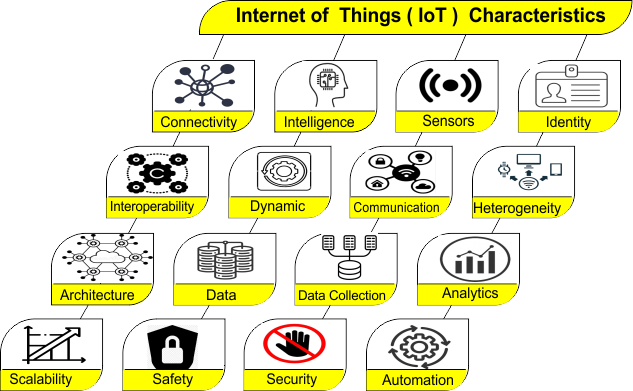
IoT has various characteristics, but the most common ones are explained below,
Significant Characteristics of IoT
The characteristics of IoT are as follows. Let’s discuss it one by one.
1. Connectivity – IoT links Devices Together
The Internet of Things (IoT) is a network of various devices that are interconnected and are capable of collecting and exchanging data. These devices, which include from simple sensors to smartphones and wearable devices, are equipped with technology that allows them to communicate with each other over the Internet.
Connectivity is an essential pillar of the IoT infrastructure. IoT devices should be connected regardless of their presence. Without connection, nothing makes sense.
Lets explain the following diagram of connectivity in detail

Key Technologies in connectivity
- Wi-Fi: It is a wireless network which connects IoT devices to the internet. It is mostly found in homes and offices.
- Bluetooth: This technology is often good for short-range communication. Bluetooth plays an important role in the IoT by providing low-power, cost-effective and reliable connectivity solutions. For example, it allows peripheral devices to connect to mobile phones, desktops, and laptops.
- Cellular Networks (2G, 3G, 4G, 5G): IoT devices can connect over long distances through these networks, which is need for remote monitoring and control. As we move from 2G to 5G, IoT devices can do more things faster and better. Devices can send and receive data faster, with less delay, handle more devices simultaneously, and work more effectively.
- LPWAN (Low Power Wide Area Network) technology is ideal for applications where devices need to communicate small amounts of data long distance (covering several kilometers) with minimum power consumption (run batteries for years). It also has the ability to handle a large number of connected devices.
- RFID (Radio Frequency Identification): It uses electromagnetic fields to automatically identify and track tags attached to objects. In IoT the RFID technology is commonly used in Retail Management, Smart Packaging, Library Management, Healthcare (Patient Tracking, Medication Management), Document Tracking, Vehicle Identification and Tracking, Livestock, Animal Tracking and many others.
- NFC (Near Field Communication): It is a wireless technology that enables communication between devices when they are brought close together, typically within a few centimeters. It is useful in secure transactions and data exchange.
- Zigbee and Z-Wave: These are popular wireless communication technologies used in the IoT for low-power and efficient communication.
Examples of Connectivity
- Smart homes are equipped with devices such as smart thermostats, lights, and security cameras that can be remotely controlled through the IoT technology.
- Wearable devices that monitor heart rate or blood sugar levels and send real-time data to healthcare providers are transforming healthcare monitoring.
- Smart agriculture involves the use of sensors in fields that monitor soil moisture and temperature, enabling efficient farming practices.
Challenges in Connectivity
As connectivity has number of benefits in IoT, there exist some challenges as well.
- Infrastructure Limitations: Building and maintaining strong connectivity infrastructure such as broadband networks is challenging and expensive, particularly in remote or rural areas.
- Interoperability: Ensuring different devices, systems, and networks function seamlessly together is a difficult task.
- Cybersecurity Risks: Increased connectivity raises the risk of cyber attacks.
- Affordability: The high costs of technology and internet access can prevent low-income groups from accessing them.
- Energy Consumption: The growing number of connected devices and data centers contributes to increased energy demand, which has an impact on the environment.
Important: IoT primarily refers Interconnected devices communicating over the internet.
2. Intelligence – Smart Decisions with IoT
The term “Intelligence in IoT” refers to the smart capabilities of devices connected to the internet. These devices contain sensors to collect data, software to analyze it, and the ability to make decisions based on that data. As a result, they can perform tasks without constant human interactions. From everyday objects to advanced machinery, these smart devices are able to communicate with each other and operate independently or semi-independently.
Lets explain the following diagram of intelligence in detail
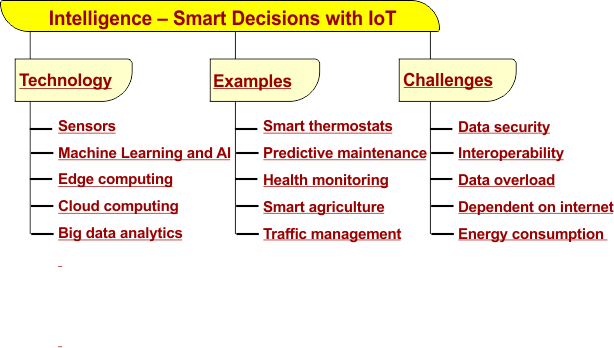
Key Technologies in intelligence
- Sensors are devices that gather data from the environment. They detect various parameters such as temperature, motion, sound, light, etc. Sensors are vital components of IoT systems as they enable devices to sense and respond to their surroundings.
- Machine Learning and AI involve developing algorithms and models that allow computers to learn from data. They make predictions or decisions without explicit programming. In IoT, these technologies enable devices to analyze data patterns, identify trends, and make intelligent decisions, enhancing automation and efficiency.
- Edge computing involves processing data closer to the source of generation, such as on the IoT device itself or in nearby servers, rather than in a centralized data center (the cloud). This approach reduces latency, improves real-time responsiveness, and decreases reliance on constant internet connectivity. It is ideal for time-sensitive applications in IoT.
- Cloud computing involves storing and processing data on remote servers accessed over the internet. In IoT, cloud services provide scalable storage and computational resources for managing and analyzing vast amounts of data generated by connected devices. Cloud computing facilitates advanced analytics, machine learning, and easy integration with other systems.
- Big data analytics refers to the process of extracting valuable insights from large and complex datasets. In the context of the Internet of Things (IoT), this involves analyzing the vast amounts of data gathered by connected devices. By studying this data, companies can gain insights into how people use products and services, optimize their operations, predict equipment failures, and much more. This, in turn, helps organizations make informed decisions and improve their overall performance.
Examples in intelligence
- Smart thermostats are devices that can learn the homeowner’s temperature preferences and adjust the temperature automatically, making it more convenient and energy-efficient.
- Predictive maintenance in manufacturing involves the use of sensors that can predict when machinery parts need maintenance or replacement, preventing downtime and saving money in the long run.
- Health monitoring wearables, such as smartwatches and fitness trackers, can track health metrics such as heart rate, sleep patterns, and exercise activity. They can also provide insights and alerts for medical attention if necessary.
- Smart agriculture uses sensors in fields to analyze soil and weather data, optimizing crop growth and reducing waste.
- Traffic management systems analyze real-time traffic data to optimize light timings and reduce congestion, resulting in improved traffic flow and reduced travel time.
Challenges in intelligence
- Data security and privacy: It is crucial to protect the vast amounts of personal and sensitive data collected by IoT devices.
- Interoperability: It is important to ensure that devices from different manufacturers can communicate effectively with each other.
- Data overload: With the huge volumes of data generated by IoT devices, it is essential to manage this data and extract useful information from it.
- Dependence on internet connectivity: IoT intelligence is often reliant on continuous internet connectivity, which can be a limitation in certain areas.
- Energy consumption: The operation and data processing in IoT devices require energy, which can impact battery life and overall energy consumption.
Important: A major challenge in IoT intelligence is Interoperability among different devices
3. Sensors – Capturing the World Around
Sensors play a crucial role in IoT by gathering information from the physical world and converting it into digital data that can be analyzed and acted upon. Ther are various kinds of sensors used in a wide range of applications.
Lets explain the following diagram of senors in detail

Key Technologies in Sensors
- RFID (Radio Frequency Identification): These sensors use radio waves to identify and track objects. They are commonly used in inventory management and supply chain tracking.
- Accelerometers: These sensors measure acceleration and tilt, commonly found in smartphones for screen orientation and activity tracking.
- Temperature and Humidity Sensors: These sensors monitor environmental conditions and are used in climate control systems, food storage, and weather monitoring.
- Proximity Sensors: These sensors detect the presence of nearby objects and are used in automatic doors, touchless faucets, and object detection systems
For example, in agriculture, soil moisture sensors can be used to monitor the hydration levels of crops, helping farmers optimize irrigation schedules. In healthcare, wearable sensors can track vital signs like heart rate and blood pressure, providing valuable insights into a person’s health condition. In smart cities, sensors in streetlights can detect movement and adjust lighting levels accordingly, saving energy.
Challenges in sensor technology
- Power Consumption: Many IoT devices are battery-powered, so sensors need to be energy-efficient to prolong battery life. High power consumption is common challenge in IoT sensors
- Data Security: Sensors collect sensitive information, so it’s crucial to ensure data encryption and secure communication protocols to prevent unauthorized access.
- Interoperability: With the proliferation of IoT devices from different manufacturers, ensuring that sensors can communicate and work together seamlessly is a challenge.
- Scalability: As the number of connected devices grows, managing and processing the vast amount of data generated by sensors becomes increasingly complex.
Important Points to remember for Sensors
- Sensors in IoT gather data from the physical world and convert it into digital information.
- Examples of sensors include RFID, accelerometers, temperature sensors, and proximity sensors.
- Sensors are used in various applications such as agriculture, healthcare, and smart cities.
- Challenges in sensor technology for IoT include power consumption, data security, interoperability, and scalability.
4. Identity of Things – Givinag IoT Devices Their Own Name
Each IoT device has its unique identity. If it needs to access the data from a specific device, its identification element is beneficial.
Imagine you have a bunch of gadgets like smart lights, cameras, or even your car, all connected to the internet. Each of these gadgets needs a way to introduce itself and prove that it’s who it claims to be. That’s where Identity of Things comes in. It’s like giving each device its own name tag, so they can be recognized and trusted within the network.
Lets explain the following diagram of identity of things in detail
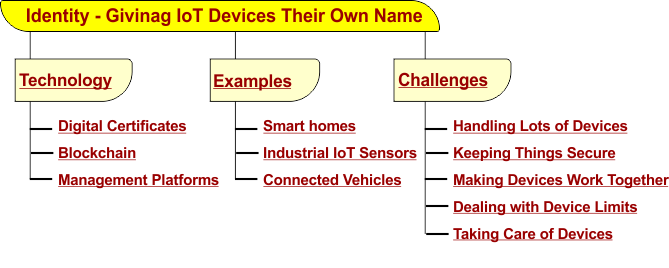
Technologies used in Identity of things
- Digital Certificates: Devices get digital IDs that work like digital ID cards, proving their authenticity.
- Blockchain: A technology that keeps a secure and unchangeable record of device identities, ensuring trust.
- Device Identity Management Platforms: Special systems that handle all aspects of device IDs, from setting them up to retiring them.
Examples for Identity of things
- Smart Home Devices: Think of your smart thermostat or security camera needing a special ID card to be part of your home network.
- Industrial IoT Sensors: Picture sensors in factories or warehouses having their own IDs to keep track of machines and products.
- Connected Vehicles: Imagine cars having unique IDs to safely communicate with other vehicles or traffic systems.
Challenges in Identity of things
- Handling Lots of Devices: Managing the identities of many devices without slowing things down.
- Keeping Things Secure: Making sure only the right devices can access data.
- Making Devices Work Together: Ensuring that different devices from different brands can still understand each other’s IDs.
- Dealing with Device Limits: Working around the fact that some devices might not have a lot of memory or power to handle fancy ID systems.
- Taking Care of Devices from Start to Finish: Making sure devices are properly set up, updated, and removed from networks when they’re not needed anymore.
5. Interoperability – Making Different IoT Devices Work Together
Interoperability in terms of IoT refers to the ability of different IoT systems, devices and applications to work together without any problem and exchange data effectively. This is crucial because IoT involves a vast network of diverse devices like sensors, appliances, vehicles, and more, each potentially using different hardware, software, and communication protocols.
Lets explain the following diagram of interoperability in detail

Technologies in interoperability
- Communication Standards: Bluetooth, Wi-Fi, Zigbee, and cellular networks like 5G.
- Protocols: MQTT (Message Queuing Telemetry Transport) and CoAP (Constrained Application Protocol) for lightweight messaging.
- APIs (Application Programming Interfaces): Enable different software components to interact.
- Cloud Platforms: Like AWS IoT, Microsoft Azure IoT which provide common platforms for data integration.
Examples in interoperability
Following are the some examples of Interoperability
- Smart Home: Various devices like thermostats, lighting systems, security cameras, and kitchen appliances communicate with each other to enhance the user’s convenience and energy efficiency.
- Healthcare: Wearable health monitors, hospital equipment, and patient databases interact to provide real-time health monitoring and alerts.
- Smart Cities: Traffic lights, pollution sensors, and public transport systems work in unison to optimize traffic flow and reduce environmental impact.
Challenges in interoperability
- Compatibility: Different manufacturers use diverse protocols and standards.
- Security: Ensuring data privacy and security across various platforms.
- Scalability: Maintaining interoperability as the number of devices in the network grows.
- Complexity: Managing a diverse and intricate network of devices and software.
6. Self Dynamic Configuring – IoT Sets Itself Up
IoT devices should dynamically adapt themselves according to situations. For example, a camera can capture data according to light conditions. It is shifted to night or day mode automatically. It is a self-adapting technique
IoT is a network of physical objects i.e. devices, vehicles, buildings, and other items which are embedded with sensors, software, and other technologies for the purpose of connecting and exchanging data with other devices and systems over the internet. “Dynamic Self-Configuring” in IoT refers to the ability of IoT devices to automatically configure and reconfigure themselves without human intervention. This adaptability is crucial for managing large, complex networks of interconnected devices that operate in varying environments.
Lets explain the following diagram of self dynamic configuration in detail
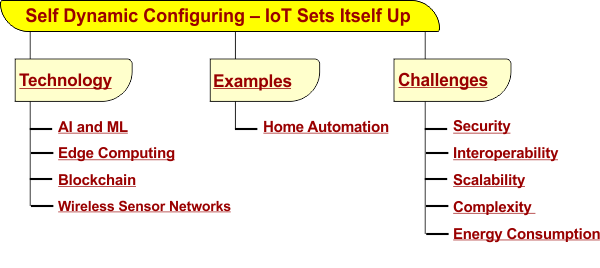
Technologies in Self Dynamic configuration
- Machine Learning and Artificial Intelligence (AI): These technologies are at the heart of dynamic self-configuring systems. IoT devices can learn from their environment, adapt to new conditions, and make decisions based on real-time data. For example, a smart thermostat can learn a household’s routine and adjust heating and cooling settings to maximize comfort and energy efficiency.
- Edge Computing: This involves processing data near the source of data generation (i.e., at the edge of the network) rather than in a centralized cloud-based data center. Edge computing reduces latency, conserves bandwidth, and enables real-time decision-making, allowing IoT devices to respond swiftly to changes in their environment.
- Blockchain and Distributed Ledger Technologies: These can provide a secure and transparent way for IoT devices to autonomously execute agreements and transactions. For instance, in a smart grid, blockchain can enable dynamic pricing and energy trading among IoT-enabled devices without the need for a central authority.
- Wireless Sensor Networks (WSN): WSNs are crucial for dynamic self-configuring IoT systems. They consist of spatially distributed autonomous sensors to monitor physical or environmental conditions. These networks can reconfigure themselves based on sensor data, optimizing their operation for data collection and communication.
Examples in Self Dynamic configuration
Home Automation is best example where devices such as thermostats, lighting systems, and security cameras can dynamically adjust settings based on user behavior, presence, and preferences. This enhances comfort, security, and energy efficiency.
Challenges in Self Dynamic configuration
- Security: Ensuring that dynamically-configuring networks are secure from hacking and unauthorized access.
- Interoperability: The need for different devices from various manufacturers to communicate effectively.
- Scalability: Ensuring systems can expand without loss of performance.
- Complexity in Management: Difficulty in managing a network that is constantly changing.
- Energy Consumption: Ensuring that IoT devices efficiently manage power usage, especially critical in battery-operated devices.
7. Communication – Talking in IoT Language
(IoT) refers to a network of physical devices, vehicles, buildings, and other items embedded with electronics, software, sensors, actuators, and connectivity, enabling these objects to collect and exchange data. It involves the interaction between IoT devices and systems. This communication is critical for data collection, transfer, and analysis, essential for IoT’s functionality. There are 3 basic types of Communication:
Lets explain the following diagram of communication in detail

- Device-to-Device: Direct communication between IoT devices, often using protocols like Bluetooth, ZigBee, or WiFi.
- Device-to-Cloud: IoT devices connect to cloud services for data analytics and storage, often through the internet.
- Device-to-Gateway: IoT devices communicate through a gateway device to the cloud or other devices, useful for managing multiple devices and performing pre-processing.
Communication Protocols
- WiFi: Widely used for high-speed internet connections.
- Bluetooth Low Energy (BLE): Ideal for short-range, low power communication.
- ZigBee: Used for creating personal area networks with small, low-power digital radios.
- LPWAN (Low Power Wide Area Network): Such as LoRaWAN, for long-range and low power needs.
- Cloud Computing: Provides storage and processing power for IoT data.
- Edge Computing: Processing data near the source to reduce latency.
- 5G Networks: Offer high speed and capacity, crucial for IoT scalability.
Challenges in Communication
- Security and Privacy: it is difficult to ensure that the data is securely transmitted and stored.
- Interoperability: Compatibility between various devices and protocols.
- Scalability: Managing a large number of devices efficiently.
- Power Consumption: Ensuring devices are energy efficient.
- Key Protocols: WiFi, Bluetooth LE, ZigBee, LPWAN.
- 5G Relevance: High speed and capacity for IoT..
8. Heterogeneity – IoT’s Made Devices compatible
Heterogeneity in IoT (Internet of Things) refers to the diverse range of devices, technologies, protocols, and platforms that make up the IoT ecosystem. IoT connects various types of devices, like sensors, smartphones, and industrial machines, to the internet, allowing them to communicate and share data.
Lets explain the following diagram of heterogeneity in detail
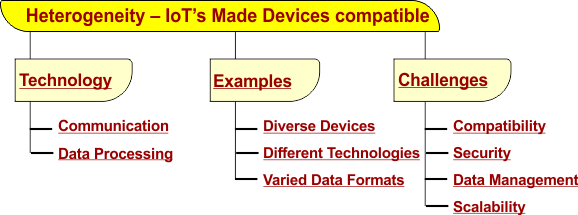
Examples in Heterogeneity
- Diverse Devices: IoT devices vary widely – from simple temperature sensors to complex industrial robots. For instance, in a smart home, a temperature sensor, a smart TV, and a security camera, all serve different purposes but are part of the same network.
- Different Technologies: These devices use different technologies and protocols (like Wi-Fi, Bluetooth, Zigbee, etc.) to connect and communicate. A smartwatch might use Bluetooth to connect to your phone, while a smart thermostat might use Wi-Fi.
- Varied Data Formats: The data generated by these devices can be in various formats. For example, a health monitor might record data in a different format than a GPS tracker.
Technologies in Heterogeneity
- Communication Technologies: Wi-Fi, Bluetooth, LTE, 5G, Zigbee, and LoRaWAN are some technologies that enable device connectivity.
- Data Processing Technologies: Cloud computing and edge computing are used to process the vast amounts of data generated by IoT devices.
Challenges in Heterogeneity
- Compatibility: Ensuring different devices and protocols work together seamlessly.
- Security: Protecting the network from cyber threats, as diverse devices increase vulnerability points.
- Data Management: Effectively handling and analyzing the large volumes of varied data.
- Scalability: Ensuring the network can grow without losing efficiency or functionality.
9. Architecture – Building IoT is Simple
IoT architecture should be hybrid, supporting different manufacturers. So, it cannot be homogeneous in nature. IoT comes into the picture when multiple domains come together.
IoT Architecture is typically divided into four layers:
- Perception Layer: This is the physical layer, consisting of sensors and actuators. Sensors collect data from the environment (like temperature, light, pressure, etc.), and actuators perform actions based on instructions (like switching on a light).
- Network Layer: This layer is responsible for transmitting the sensor data to the processing systems or the cloud. Technologies like Wi-Fi, Bluetooth, Zigbee, and cellular networks are used.
- Processing Layer (Middleware): Here, the data is analyzed, processed, and decisions are taken. This involves databases, cloud computing, and data analytics software.
- Application Layer: This is the layer where end-users interact. Applications in this layer use the processed data to provide useful results. For instance, a smart thermostat app adjusting the temperature based on your preferences.
Lets explain the following diagram of architecture in detail
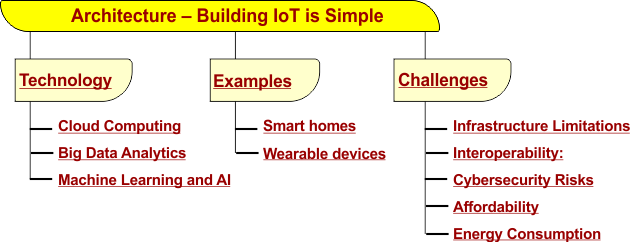
Examples in Architecture
- Smart Homes: Using IoT devices for home automation like smart thermostats, smart lights, and security systems.
- Wearable Health Devices: Smartwatches and fitness bands that track health metrics.
Technologies in Architecture
- Cloud Computing: To store and process large amounts of data.
- Big Data Analytics: For analyzing complex data patterns.
- Machine Learning and AI: For making sense of data and automation.
Challenges in Architecture
- Security and Privacy: Ensuring data protection in IoT devices is critical.
- Interoperability: Making different IoT systems work together seamlessly.
- Scalability: Managing large networks of devices effectively.
10. Data – IoT Loves Data
Data is the basic part of IoT. The following is the detail description of IoT data
- Data Collection: IoT devices collect data from the environment through sensors. For example, a smart thermostat in a home can collect data about temperature and humidity.
- Data Transmission: This data is then transmitted over a network. For example, a fitness tracker transmits data about your steps and heart rate to a smartphone app.
- Data Processing: Data collected is processed, often in real-time, to extract useful information. For instance, an industrial IoT device might process data to detect machine malfunctions.
- Data Utilization: The processed data is used to make decisions and take actions. For example, smart irrigation systems in agriculture use soil moisture data to automatically adjust watering.
Lets explain the following diagram of data in detail
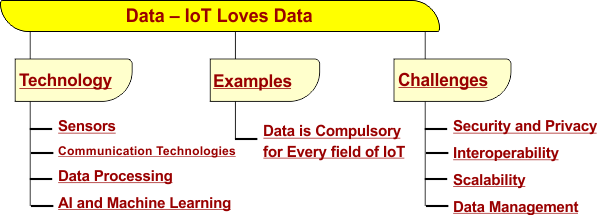
Technologies in Data
- Sensors: Devices that detect changes in the environment and send data. Example: Temperature sensors in smart ACs.
- Communication Technologies: These include Wi-Fi, Bluetooth, and cellular networks, enabling devices to connect and communicate.
- Data Processing and Storage: Cloud computing is often used for storing and analyzing large volumes of data from IoT devices.
- AI and Machine Learning: These technologies are used for making sense of vast amounts of data, such as predictive maintenance in manufacturing.
Challenges in Data
- Security and Privacy: Protecting data from unauthorized access is a significant challenge, especially personal data collected by smart home devices.
- Interoperability: Ensuring different devices and systems can work together seamlessly.
- Scalability: Managing a rapidly growing number of IoT devices is a logistical and technical challenge.
- Data Management: Effectively storing, processing, and analyzing the huge volumes of data generated by IoT devices.
11. Data Collection – Gathering IoT Insights – Starting Point
Data collection in IoT is a critical component where these devices gather information from their environment.
How IoT Collects Data
- Sensors: These are the primary tools for data collection in IoT. Sensors can detect and measure various types of physical or environmental conditions, such as temperature, motion, light, and sound. For example, a temperature sensor in a smart thermostat collects data about the room temperature.
- Connectivity: IoT devices transmit the collected data via networks such as Wi-Fi, Bluetooth, and cellular networks.
Lets explain the following diagram of data collection in detail

Examples of Data Collection
- Smart Homes: Devices like smart thermostats, security cameras, and lighting systems collect data on user behavior, temperature, and light to optimize home environments.
- Agriculture: Sensors in farms can collect data about soil moisture and nutrients, helping in precise farming methods.
- Healthcare: Wearable devices like fitness trackers collect data on heart rate, steps, and sleep patterns for health monitoring.
Technologies in Data Collection
- RFID Tags: Used for tracking movement of goods in supply chain management.
- GPS: Enables location tracking for devices and vehicles.
- Low-power Wide-area Networks (LPWAN): Used for transmitting small amounts of data over long distances, suitable for remote sensors.
Challenges in Data Collection
- Security and Privacy: Protecting the vast amount of data collected from unauthorized access and breaches.
- Data Overload: Handling the large volume of data that IoT devices generate can be challenging in terms of storage and analysis.
- Interoperability: Ensuring different IoT devices and systems can work together seamlessly.
- Energy Consumption: Many IoT devices are battery-powered, so efficient energy use is crucial.
12. Analytics – Making Sense of IoT Data
Analyzing the IoT data helps in gaining insights that drive better decision-making, improve processes, and enable predictive maintenance.
Lets explain the following diagram of analytics in detail

Examples in Analytics
- Smart Homes: IoT devices like smart thermostats and lighting systems collect data on user preferences and environmental conditions to optimize energy usage.
- Healthcare: Wearables track vital signs and predict health issues before they become severe.
- Agriculture: Sensors in fields analyze soil conditions and climate, helping in efficient water usage and crop management.
- Manufacturing: IoT sensors in machinery predict maintenance needs to avoid costly downtimes.
Technologies in Analytics
- Big Data Platforms: Tools like Hadoop and Spark efficiently process large volumes of IoT data.
- Cloud Computing: Offers scalable resources for storage and analytics.
- Machine Learning and AI: Algorithms that learn from data to make predictions or decisions.
- Edge Computing: Processing data at or near the source to reduce latency.
Challenges in Analytics
- Data Privacy and Security: Protecting sensitive information collected by IoT devices.
- Data Volume and Management: Handling the immense volume of data generated by IoT devices.
- Integration with Existing Systems: Ensuring IoT systems work seamlessly with existing infrastructure.
- Skill Gap: Need for skilled professionals in IoT and analytics.
13. Scalability – Easy to grow IoT Network
The number of IoT devices is increasing day by day. Hence, an IoT’s scalability should be enough to handle the massive traffic. Scalability in the context of IoT refers to the capacity of an IoT system to grow and manage as the demand is increased. As more devices connect to the Internet, the IoT system must be able to handle large volumes of data, more connections, and increased complexity without compromising performance or efficiency.
Lets explain the following diagram of scalability in detail
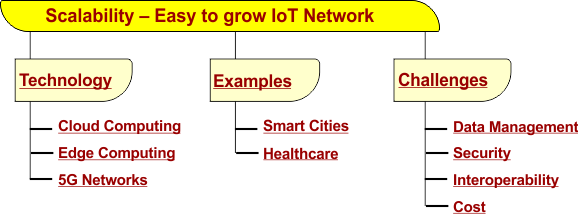
Examples in scalability
- Smart Cities: A scalable IoT system in a smart city can handle adding more sensors for traffic, pollution, and energy management as the city grows.
- Healthcare: Hospitals adding more patient monitoring devices without overloading the existing network.
Technologies in scalability
- Cloud Computing: Enables IoT scalability by providing vast data storage and processing power.
- Edge Computing: Processes data closer to IoT devices, reducing latency and network congestion.
- 5G Networks: Offer faster speeds and can handle more devices simultaneously.
Challenges in scalability
- Data Management: Managing the massive influx of data from numerous devices.
- Security: As more devices connect, maintaining security becomes more challenging.
- Interoperability: Ensuring different devices and systems can work together effectively.
- Cost: Scaling IoT systems can be expensive, especially for infrastructure upgrades.
14. Safety – Protect environment from any physical harm
Safety should be the top priority. But in the case of IoT, Safety is a big challenge because multiple things are connected through the internet. And safety at spot is a critical and challenging task.
The Internet of Things (IoT) refers to a network of interconnected devices that can collect and exchange data. Safety in IoT encompasses measures and practices to protect these devices and the networks they operate on from various threats, including unauthorized access, hacking, and misuse.
Lets explain the following diagram of safety in detail

Examples in Safety
- Smart Home Devices: Thermostats, lighting systems, security cameras.
- Wearables: Fitness trackers, smartwatches.
- Industrial IoT: Sensors in manufacturing equipment, supply chain trackers.
- Smart Cities: Traffic control, waste management systems.
Technologies in Safety
- Secure Hardware: Designing devices with built-in security features.
- Authentication Protocols: Ensuring only authorized devices and users can access the network.
- Cloud Security: Protecting data stored on remote servers.
Challenges in Safety
- Network Security: IoT devices often use public networks, increasing vulnerability to attacks.
- Physical Security of Devices: Many IoT devices are in easily accessible locations, making them prone to physical tampering.
15. Security – Protecting data from unauthorized access
IoT security is the practice of safeguarding connected devices and networks in the Internet of Things (IoT). Since these devices are interconnected and often collect and transmit data, ensuring their security is crucial to protect against unauthorized access and cyber threats.
Lets explain the following diagram of security in detail

Examples in security
- Smart Homes: Security measures in smart home devices like smart locks, thermostats, and cameras. For example, encryption of data to prevent unauthorized access.
- Healthcare Devices: Wearable devices that monitor health parameters need secure data transmission to protect patient privacy.
Technologies in security
- Encryption: Encoding data so only authorized parties can read it.
- Secure Boot: Ensuring that the device boots using software that is trusted by the manufacturer.
- Access Control: Limiting who can interact with the device and data.
- Regular Software Updates: To patch vulnerabilities and keep security measures up-to-date.
Challenges in security
- Scale & Diversity of Devices: Numerous and varied devices make uniform security policies difficult.
- Data Privacy: Massive data generation poses privacy issues.
- Interoperability: Different devices and protocols may have different security standards.
- Resource Constraints: Many IoT devices have limited processing power, which can constrain security measures.
16. Automation – Making Things Work Automatically in IoT
Automation in IoT perform tasks automatically without or with minimal human intervention. IoT links physical objects with internet connectivity, enabling data exchange and automated actions.
Lets explain the following diagram of automation in detail
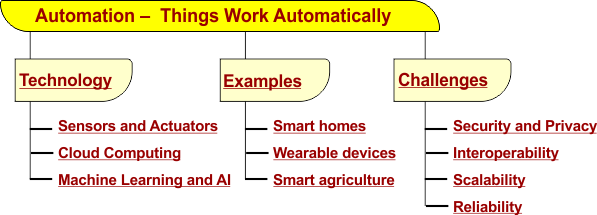
Technologies in automation
- Sensors and Actuators: Collect data and physically interact with the environment.
- Cloud Computing: Offers storage and processing power for IoT data.
- Machine Learning and AI: Enable intelligent decision-making by analyzing vast amounts of data.
Challenges in automation
- Security and Privacy: Protecting sensitive data against unauthorized access.
- Interoperability: Ensuring different devices and systems can work together.
- Scalability: Handling the increasing number of devices and data volumes.
- Reliability: Ensuring systems function correctly and consistently.
Examples in automation
- Smart Homes: Thermostats adjust the temperature based on your preferences.
- Agriculture: Sensors in fields monitor soil moisture and automate irrigation systems.
- Healthcare: Wearable devices track health metrics and alert healthcare providers in emergencies









